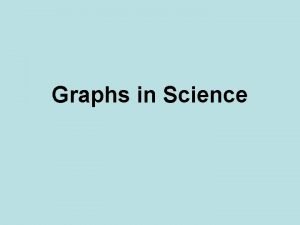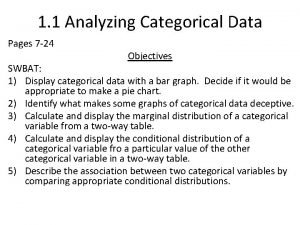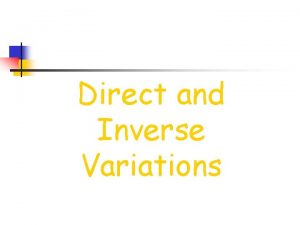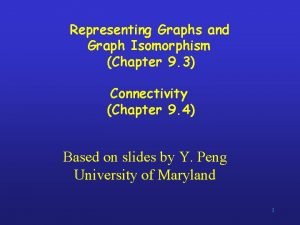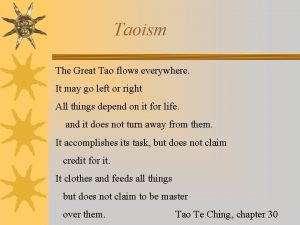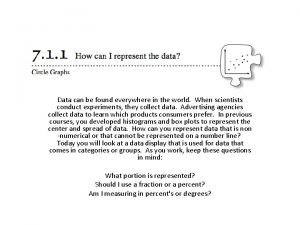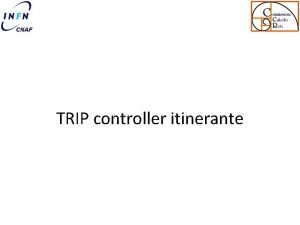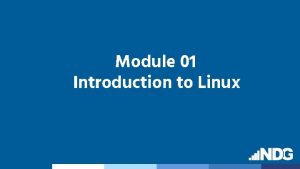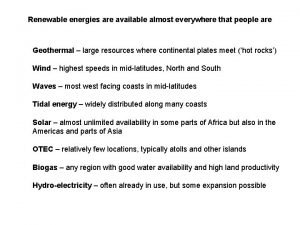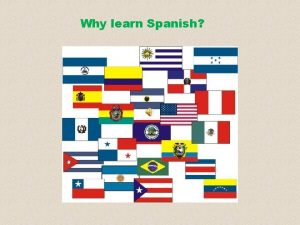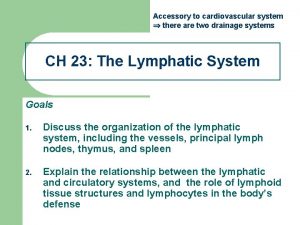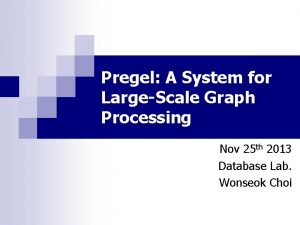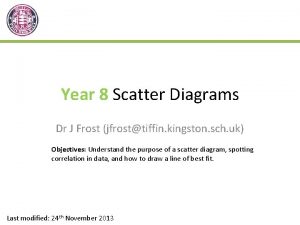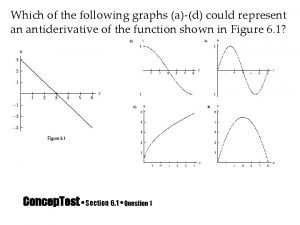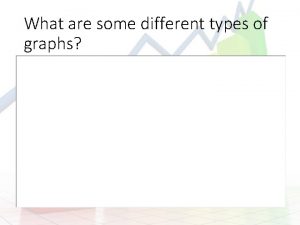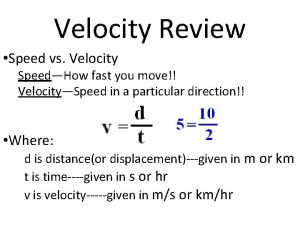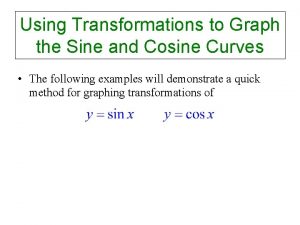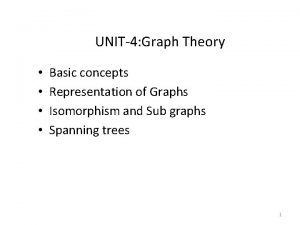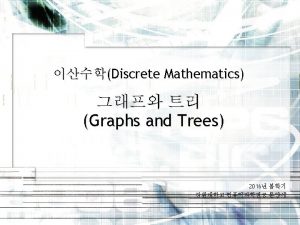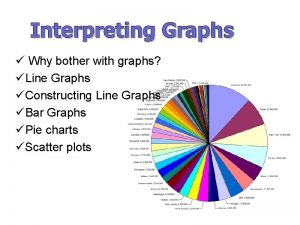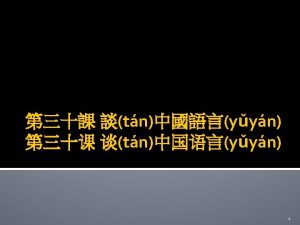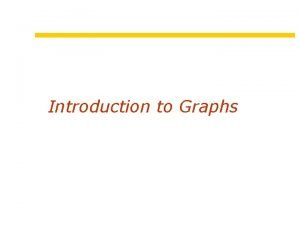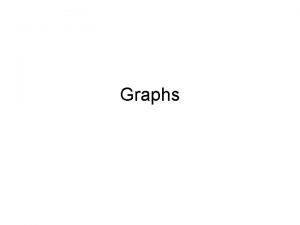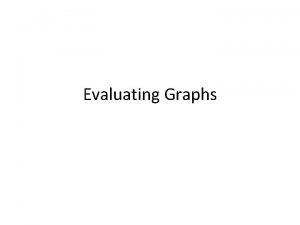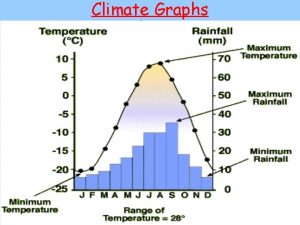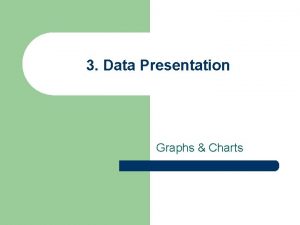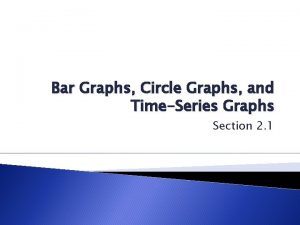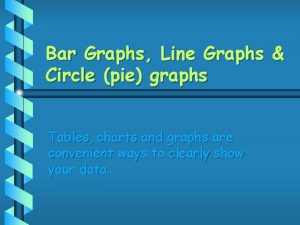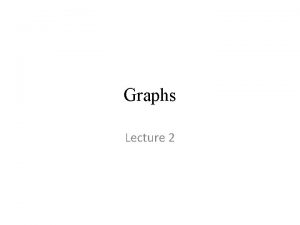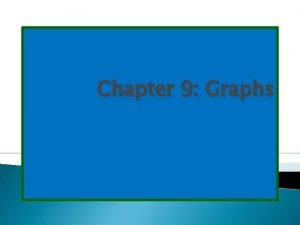GRAPH PROCESSING Why Graph Processing Graphs are everywhere
































































































- Slides: 96

GRAPH PROCESSING

Why Graph Processing? Graphs are everywhere!

Why Graph Processing?

Why Distributed Graph Processing? They are getting bigger!

Road Scale >24 million vertices >58 million edges *Route Planning in Road Networks - 2008

Social Scale >1 billion vertices ~1 trillion edges *Facebook Engineering Blog ~41 million vertices >1. 4 billion edges *Twitter Graph- 2010

Web Scale >50 billion vertices >1 trillion edges *NSA Big Graph Experiment- 2013

Brain Scale >100 billion vertices >100 trillion edges *NSA Big Graph Experiment- 2013

Lumsdaine, Andrew, et al. "Challenges in parallel graph processing. " Parallel Processing Letters 17. 01 -2007 CHALLENGES IN PARALLEL GRAPH PROCESSING

Challenges 1 Structure driven computation 2 Irregular Structure Data Transfer Issues Partitioning Issues *Concept borrowed from Cristina Abad’s Ph. D defense slides

Overcoming the challenges 1 Extend Existing Paradigms 2 BUILD NEW FRAMEWORKS!

Build New Graph Frameworks! Key Requirements from Graph Processing Frameworks

1 2 3 4 5 Less pre-processing Low and load-balanced computation Low and load-balanced communication Low memory footprint Scalable wrt cluster size and graph size

Malewicz, Grzegorz, et al. "Pregel: a system for large-scale graph processing. “ ACM SIGMOD -2010. PREGEL

Life of a Vertex Program Iteration 0 Placement Of Vertices Iteration 1 Computation Barrier Computation Communication Barrier Time *Concept borrowed from LFGraph Slides

Sample Graph B D A C E *Graph Borrowed from LFGraph Paper

Shortest Path Example B D A C E

Iteration 0 B 0 D ∞ M es sa ge (0+ 1) A ∞ C ∞ E ∞

Iteration 1 B 0 ge a ss D ∞ 1) + (1 e M A 1 C ∞ Me ssa ge (1+ 1) E ∞

Iteration 2 B 0 D 2 A 1 C ∞ E 2

Can we do better? GOAL PREGEL Computation 1 Pass Communication ∝ #Edge cuts Pre-processing Cheap (Hash) Memory High (out edges + buffered messages)

Hoque, Imranul, and Indranil Gupta. "LFGraph: Simple and Fast Distributed Graph Analytics”. TRIOS-2013 LFGRAPH – YES, WE CAN!

Features B D Cheap Vertex Placement: Hash Based A CLow graph initialization time. E

Features BPublish Subscribe fetch once D information flow A Low communication overhead C E

Subscribe B D A C Subscribing to vertex A E

Publish B D A C Publish List of Server 1: (Server 2, A) E

LFGraph Model B D A C Value of A E

Features B D Only stores in-neighbor vertices A C Reduces memory footprint. E

In-neighbor storage B Local in-neighbor – simply read the value C D A Remote in-neighbor – read locally available value E

Iteration 0 B 0 D ∞ A ∞ C ∞ E ∞

Iteration 1 B 0 C ∞ Re ad ad e R va lue e∞ u l va D ∞ 0 A ∞ 1 Value change in duplicate store Value of A E ∞

Iteration 2 B 0 D ∞ 2 Local read of A A 1 C ∞ Local read of A E ∞ 2

Features B Single Pass Computation D A C Low computation overhead. E

Life of a Vertex Program Iteration 0 Iteration 1 Placement Computation Communication Of Vertices Barrier Computation Communication Barrier Time *Concept Borrowed from LFGraph Slides

How everything Works


Low, Yucheng, et al. "Graphlab: A new framework for parallel machine learning”. Conference on Uncertainty in Artificial Intelligence (UAI) - 2010 GRAPHLAB

Graph. Lab Model B D A C D A E E

Can we do better? GOAL GRAPHLAB Computation 2 passes Communication ∝ #Vertex Ghosts Pre-processing Cheap (Hash) Memory High (in & out edges + ghost values)

Gonzalez, Joseph E. , et al. "Powergraph: Distributed graph-parallel computation on natural graphs. " USENIX OSDI - 2012. POWERGRAPH

Power. Graph Model B D A 1 C A 2 E

Can we do better? GOAL POWERGRAPH Computation 2 passes Communication ∝ #Vertex Mirrors Pre-processing Expensive (Intelligent) Memory High (in & out edges + mirror values)

Communication Analysis External on edge cuts Ghost vertices in and out neighbors Mirrors in and out neighbors External in neighbors

Computation Balance Analysis • Power Law graphs have substantial load imbalance. • Power law graphs have degree d with probability proportional to d-α. • Lower α means a denser graph with more high degree vertices.

Computation Balance Analysis

Computation Balance Analysis

Real World vs Power Law

Communication Balance Analysis

Page. Rank – Runtime w/o partition

Page. Rank – Runtime with partition

Page. Rank – Memory footprint

Page. Rank – Network Communication

Scalability

X-Stream: Edge-centric Graph Processing using Streaming Partitions * Some figures adopted from author’s presentation

Motivation • Can sequential access be used instead of random access? ! • Can large graph processing be done on a single machine? ! X-Stream

Sequential Access: Key to Performance! Medium Read (MB/s) Write (MB/s) Random Sequential Speed up RAM (1 core) 567 2605 4. 6 1057 2248 2. 2 RAM (16 core) 14198 25658 1. 9 10044 13384 1. 4 SSD 22. 5 667. 69 29. 7 48. 6 576. 5 11. 9 Magnetic Disk 0. 6 328 546. 7 2 316. 3 158. 2 Speed up of sequential access over random access in different media Test bed: 64 GB RAM + 200 GB SSD + 3 TB drive

How to Use Sequential Access? Edge-Centric Processing Sequential access …

Vertex-Centric Scatter U {state} Upda te u 1 U e at pd u 2 e un Updat for each vertex v if state has updated for each output edge e of v scatter update on e

Vertex-Centric Gather Upda pd at e Update v n te v 1 U v 2 V {state} {state 2} for each vertex v for each input edge e of v if e has an update apply update on state

Vertex-Centric x e d 1 5 In p 6 3 V 8 BFS 7 4 2 1 2 3 4 5 6 7 8 L ku o o SOURCE DEST 1 1 2 2 3 3 4 4 4 3 5 7 4 2 8 3 7 8 5 6 8 8 6 1 5 6

Edge-Centric Scatter Update u 1 A for each edge e if e. source has updated scatter update on e B Update un C = Updated Vertex

Edge-Centric Gather Update u 1 X Update u 2 for each update u on edge e apply update u to e. destination Y Update un Z = Updated Vertex

Sequential Access via Edge-Centric! In Slow Storage In Fast Storage In Slow Storage

Fast and Slow Storage

Edge-Centric 1 Lots 6 of wasted reads! 3 V 1 5 SOURCE DEST 1 1 2 2 3 3 4 4 4 3 5 7 4 2 8 3 7 8 5 6 8 8 6 1 5 6 Large makes 2 2 7 Diameter 3 X-Stream slow and wasteful 8 4 4 5 6 7 8 Most real world graphs have small diameter BFS

Order is not important SOURCE No DEST 1 3 1 5 2 7 2 4 3 2 pre-processing 3 8 4 3 4 7 4 8 5 6 8 8 6 1 5 6 SOURCE = (sorting and DEST 1 3 8 6 5 6 2 4 3 2 indexing) 4 7 4 3 3 8 4 8 2 6 8 1 needed! 7 1 5 5 66

But, still … • Random access for vertices • Vertices may not fit into fast storage n i m a e Str s n o i t g Par

Streaming Partitions V=Subset of vertices Mutually disjoint E=Outgoing edges of V Constant set U=Incoming updates to V Changing in each scatter phase

Scatter and Shuffle Fast Memory V 1 Load E 1 U 1 v 2 v 3 … Read source Stream e 1 e 2 e 3 … Vn En Un Input buffer Add update u 1 u 2 u 3 … … Vertex set Update buffer Shuffle u'1 u'2 u'3 … Append to updates Output buffer

Shuffle Stream Buffer with k partitions

Gather Fast Memory V 1 Load E 1 U 1 v 2 v 3 … Vertex set Apply update Stream u 1 u 2 u 3 … Update buffer No output!

Parallelism • State stored in vertices • Disjoint vertex set in partitions Compute partitions in parallel Parallel scatter and gather

Experimental Results

X-Stream Speedup over Graphchi RMAT 27/WCC Twitter/Belief Propagation Mean Speedup = 2. 3 Twitter/Pagerank Netflix/ALS 0 1 2 3 4 5 Speedup without considering the pre-process time of Graphchi 6

X-Stream Speedup over Graphchi RMAT 27/WCC Twitter/Belief Propagation Mean Speedup = 3. 7 Twitter/Pagerank Netflix/ALS 0 1 2 3 4 Speedup considering the pre-process time of Graphchi 5 6

3000 2500 2000 1500 1000 500 0 W 27 / AT el /B er itt Tw CC . . ie f. P ag /P er itt RM an er ix/ AL Tw ro p. k S Graphchi Sharding X-Stream runtime Ne tfl Time (sec) X-Stream Runtime vs Graphchi Sharding

Disk Transfer Rates Metric X-Stream Graphchi Data moved 224 GB 322 GB Time taken 398 seconds 2613 seconds Transfer rate 578 MB/s 126 MB/s Data transfer rates on Page Rank algorithm on Twitter workload SSD sustain reads = 667 MB/s, writes = 576 MB/s 77

Scalability on Input Data size 256 Million V, 4 Billion E, 33 mins 4 Billion V, 64 Billion E, 26 hours 8 Million V, 128 Million E, 8 sec RAM SSD Disk 4 M 76 B 8 M 15 B 36 M B 3 G B 6 G B 12 GB 24 GB 48 GB 96 GB 19 2 G 38 B 4 G 76 B 8 G B 1. 5 T B : 00: 01 : 30: 01 : 22: 31 : 05: 38 : 01: 25 : 00: 22 : 00: 06 : 00: 02 38 Time (HH: MM: SS) Weakly Connected Components

Discussion • Features like global values, aggregation functions, asynchronous computation missing from LFGraph. Will the overhead of adding these features slow it down? • LFGraph assumes that all edge values are same. If the edge values are not, either the receiving vertices or the server will have to incorporate that value. Overheads? • LFGraph has one pass computation but then it executes the vertex program at each vertex (active or inactive). Trade-off?

Discussion • Independent computation and communication rounds may not always be preferred. Use bandwidth when available. • Faul Tolerance is another feature missing from LFGraph. Overheads? • Three benchmarks for experiments. Enough evaluation? • Scalability comparison with Pregel with different experiment settings. Memory comparison with Power. Graph based on heap values from logs. Fair experiments?

Discussion • Could the system become asynchronous? • Could the scatter and gather phase be combined into one phase? • Does not support iterating over the edges/updates of a vertex. Can this be added? • How good do they determine number of partitions? • Can shuffle be optimized by counting the updates of each partition during scatter?

Thank you for listening! Questions?

Backup Slides

Reason for Improvement

Qualitative Comparison GOAL PREGEL GRAPHLAB POWERGRAPH LFGRAPH Computation 2 passes, Combiners 2 passes 1 pass Communication ∝ #Edge cuts ∝ #Vertex Ghosts ∝ #Vertex Mirrors ∝ #External inneighbors Pre-processing Cheap (Hash) Expensive (Intelligent) Cheap (Hash) Memory High (out edges + buffered messages) High (in & out edges + ghost values) High (in & out edges + mirror values) Low (in edges + remote values)

Backup Slides

Read (MB/s) Read Bandwidth - SSD 1000 900 800 700 600 500 400 300 200 100 0 X-Stream Graphchi 5 minute window

Write Bandwidth - SSD 800 700 Write (MB/s) 600 500 X-Stream Graphchi 400 300 200 100 0 5 minute window

Scalability on Thread Count

Scalability on Number of I/O Devices

Sharding-Computing Breakdown in Graphchi 1 0. 9 0. 8 0. 7 0. 6 0. 5 0. 4 0. 3 0. 2 0. 1 0 CC . . . Benchmark /W AT 27 RM ro ie f. P /B el er itt Tw Tw itt er /P tfl i ag e x/ ra pa nk AL S Compute + I/O Ne Fraction of Runtime Graphchi Runtime Breakdown Re-sort shard

X-Stream not Always Perfect

Large Diameter makes X-stream Slow!

In-Memory X-Stream Performance Runtime (s) Lower is better BFS (32 M vertices/256 M edges) 100 80 60 40 20 0 1 2 4 8 Threads 16 BFS-1 [HPC 2010] BFS-2 [PACT 2011] X-Stream

Ligra vs. X-Stream

Discussion • The current implementation is on a single machine, can it be extended to clusters? – Would it still perform good – How to provide fault tolerance and synchronization? • The waste rate is high (~65%). Could this be improved? • Can the partition be more intelligent? Dynamic partitioning? • Could all vertex-centric programs be converted to edge-centric? • When does streaming outperform random access?
 Antigentest åre
Antigentest åre Logos everywhere
Logos everywhere Why why why why
Why why why why Good state graphs and bad state graphs
Good state graphs and bad state graphs Graphs that compare distance and time are called
Graphs that compare distance and time are called Graphs that enlighten and graphs that deceive
Graphs that enlighten and graphs that deceive End behaviour chart
End behaviour chart Dont ask
Dont ask Why are line graphs powerful tools in science
Why are line graphs powerful tools in science Why are line graphs powerful tools in science?
Why are line graphs powerful tools in science? Why do statisticians prefer bar graphs
Why do statisticians prefer bar graphs Euler circuit
Euler circuit Direct inverse graph
Direct inverse graph Algorithmic graph theory and perfect graphs
Algorithmic graph theory and perfect graphs Representing graphs and graph isomorphism
Representing graphs and graph isomorphism Representing graphs and graph isomorphism
Representing graphs and graph isomorphism I've been everywhere canada
I've been everywhere canada Taoism philosophy
Taoism philosophy Security that fits everywhere
Security that fits everywhere Linux everywhere
Linux everywhere It's just everywhere sexism in schools
It's just everywhere sexism in schools Presentation about love and friendship
Presentation about love and friendship Clot retraction
Clot retraction Every learner everywhere
Every learner everywhere Don't leave home without it slogan
Don't leave home without it slogan All traffic signs and meanings
All traffic signs and meanings Joshua 1:9 csb
Joshua 1:9 csb Hrm vs hrd
Hrm vs hrd Educational excellence everywhere
Educational excellence everywhere Apples here apples there
Apples here apples there Adverb definition
Adverb definition Every learner everywhere
Every learner everywhere Class 8 english chapter 7 water water everywhere
Class 8 english chapter 7 water water everywhere Sit everywhere
Sit everywhere Injustice anywhere is a threat to justice everywhere essay
Injustice anywhere is a threat to justice everywhere essay Ethernet everywhere
Ethernet everywhere It can be found everywhere
It can be found everywhere Getting started with poll everywhere
Getting started with poll everywhere Chemistry is everywhere
Chemistry is everywhere Come lord jesus be our guest
Come lord jesus be our guest Water water everywhere project
Water water everywhere project Trips everywhere 3
Trips everywhere 3 Ssl everywhere
Ssl everywhere Prayer example
Prayer example Linux is everywhere
Linux is everywhere I'm singing for my lord everywhere i go lyrics
I'm singing for my lord everywhere i go lyrics Men pray everywhere
Men pray everywhere An element of poetry
An element of poetry Everywhere opposite
Everywhere opposite Unit 11 water water everywhere
Unit 11 water water everywhere Hindu beliefs about god
Hindu beliefs about god Sac spider bite
Sac spider bite Internet everywhere 2017
Internet everywhere 2017 Than almost everywhere
Than almost everywhere 2 broke teachers
2 broke teachers Sitting anywhere at work
Sitting anywhere at work Wegolook app
Wegolook app I go everywhere you go
I go everywhere you go Poll everywhere nus
Poll everywhere nus English is everywhere
English is everywhere Everywhere in spanish
Everywhere in spanish Trips everywhere
Trips everywhere Nus cit
Nus cit Ucl desktop everywhere
Ucl desktop everywhere Lymphatic vessels are located everywhere except the
Lymphatic vessels are located everywhere except the Top down procesing
Top down procesing Gloria suarez
Gloria suarez Bottom-up processing examples
Bottom-up processing examples Neighborhood processing in image processing
Neighborhood processing in image processing Primary and secondary processing
Primary and secondary processing Point processing in digital image processing
Point processing in digital image processing Histogram processing in digital image processing
Histogram processing in digital image processing Parallel processing vs concurrent processing
Parallel processing vs concurrent processing Nonlinear image processing
Nonlinear image processing پردازش تصویر
پردازش تصویر Morphological dilation
Morphological dilation Top down processing example
Top down processing example Batch processing and interactive processing
Batch processing and interactive processing Pregel: a system for large-scale graph processing
Pregel: a system for large-scale graph processing Graph processing
Graph processing Why-why analysis
Why-why analysis Wh tongue twisters
Wh tongue twisters Does the table represent a function why or why not
Does the table represent a function why or why not Does this table represent a function why or why not
Does this table represent a function why or why not Why or why not
Why or why not Contoh root cause analysis 5 why
Contoh root cause analysis 5 why Handshaking theorem
Handshaking theorem Wait-for graph
Wait-for graph Dr frost scatter graphs
Dr frost scatter graphs Proportion formula
Proportion formula Which of the following graphs are identical?
Which of the following graphs are identical? Different type of graphs
Different type of graphs Constant velocity graph
Constant velocity graph Graph of sine and cosine functions
Graph of sine and cosine functions Graph theory basic concepts
Graph theory basic concepts State graph in software testing
State graph in software testing Perfect competition side by side graphs
Perfect competition side by side graphs








